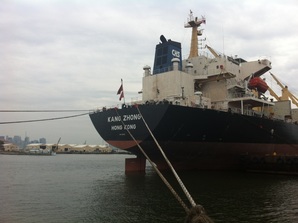Marine and Cargo Surveyor's Blog
Just a few thoughts from your local Marine and Cargo Surveyor. Check back often as I will try to post as frequently as I can.
 Draft surveys are a type of inspection used to determine the amount of cargo loaded on or unloaded from a ship. This survey is conducted twice during the passage of a cargo-bearing vessel in an international or local port – at the entry and the exit. Technically it is based on the principle of Archimedes: “An object that is either partly or completed immersed in a body of water receives an upward thrust that is equal to the weight of the water it displace.” Therefore, minus the known constants of requisite liquids on the ship, as well as the ship’s own weight, the displacement figure would give a very accurate estimate of the total amount of cargo loaded on the ship in question. Here is a very basic overview of the draft survey process. Step 1 – Reading drafts Normally, a draft scale is painted on the port side of a ship in Roman numerals, while the same scale exists in Arabic numerals on the starboard side. International convention dictates that the former scale should be marked in feet while the latter in decimeters. These draft scales are located fore and aft, as close to the ends of the ship’s length as possible. However, oftentimes these scales can also be found marked at the midship; the center of the ship, lengthwise. It is important for accuracy to not allow any sort of actions on the ship that could tamper with the readings while a draft survey is being carried out. Normally, such actions involve liquid transfer, like the uptake and discharge of ballast, fuel, fresh water, etc. Likewise, the movement of cranes is also ceased during a draft survey to stop any unwarranted loading or unloading. Ideally, the ship’s draft should be the same at both the fore and the aft. But this is not usually the case because of the dynamic forces that are in play during the measurement. This is why there is a need for draft correction. Step 2 – Draft correction As stated earlier, while in water, the ship is subjected to a multitude of forces. This is why it is very difficult for the vessel to be perfectly upright and have its keel in a straight line – both of which are requirements for an accurate draft reading. Thus appropriate adjustments to the draft are needed to correct for the ship’s behavior as a flexible beam undergoing deformations under the force of buoyancy and weight distribution. The initial correction involves the adjusting of the fore and aft draft measurements, as if they were taken from scales marked on the bow and stern of the ship – effectively perpendicular to the waterline. Furthermore, keel adjustments through hydrostatics is also employed as well as the rectification for water density. The latter is very important as depending upon the density of the water the ship is in, its draft can vary considerably. This is why a hydrometer is used to measure the density at various points around the ship being drafted. All of the data collected in this step is recorded in a Hydrostatic Table that is present aboard the ship. Step 3 – Weight correction Cargo is not the only thing a ship carries that is of considerable weight. Variable weights on a cargo ship include ballast water, diesel oil, fuel oil, bilge water and fresh water. They have to be taken in account to calculate the true cargo weight. Normally tank levels are measured by sounding tape or ultrasonic liquid level meter. This value of level is used to calculate the volume of the respective liquid, after which it is multiplied by a density factor. Fuel volumes are customarily corrected for temperature. If you or your company are in need of a qualified and experienced draft surveying company in the New York, New Jersey, or anywhere else, do not hesitate to reach out to us. We would be happy to discuss your needs and how we might be able to help you in accomplishing your goals in an economical and efficient manner. We're based in Secaucus, NJ, but travel to service clients all over the Northeast, United States, and World.
Comments are closed.
|
AuthorZach Vergiev is a Marine and Cargo Surveyor with many years of experience serving clients through the New York, New Jersey, and the World. Archives
August 2016
Categories
All
|
|
BMP Marine Consultants and Surveyors
Secaucus, NJ 07094 |
BMP Marine Consultants and Surveyors
Copyright © 2012 - 2023. All rights reserved. |